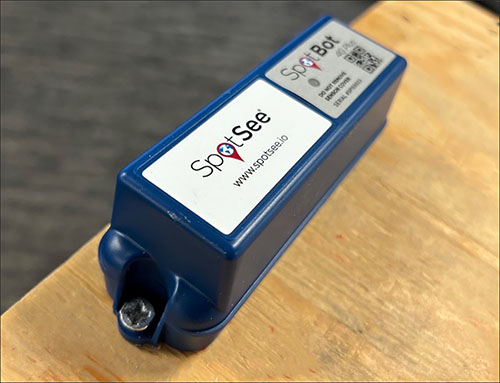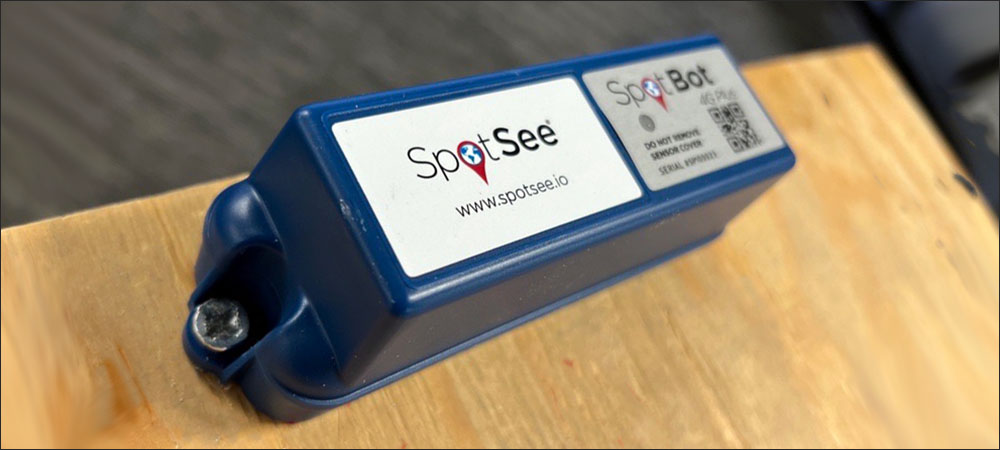RFID Journal LIVE! 2023 will feature end-user companies discussing RFID’s use in various industries, including supply chain and pharmaceuticals, as well as exhibitors offering tagging solutions for multiple applications. To learn more, visit the event’s website.
Condition-monitoring technology company Spotsee has released a device designed to help businesses track not only the locations of their products, but also any shock events that may have occurred. The solution monitors the temperatures and other sensor-based conditions to which those goods have been exposed during transit or in storage.
The SpotBot 4G is a wireless device that comes with sensors for monitoring impact, temperature and location, and it is slated to offer humidity and light detection as well, later this year. The device sends data via a 4G LTE-M or Wi-Fi connection, SpotSee reports, and it includes GPS technology and proximity sensing based on Wi-Fi signals. According to the company, that data includes measurements of the conditions to which goods are exposed while in transit.

The SpotBot 4G
SpotSee initially offered a radio frequency identification (RFID)-based solution to help companies view whether products might have been damaged due to an impact during transit (see RFID Detects Drops, Falls and Impacts with Shock-Sensitive Goods). That feature has since been adopted largely by businesses whose products are vulnerable to shock, such as automotive, power-generation, fragile equipment and semiconductor manufacturers.
Now, SpotSee says that it has a much larger customer list with a more expansive set of needs. Therefore, the company’s latest version, released in February 2023, includes impact-detection functionality, with greater flexibility than previous versions, and it can measure any impact between 3.5 and 100G, according to Tony Fonk, SpotSee’s CEO.
Supply Chain Visibility for Life Sciences
The SpotBot 4G’s predecessor, the Spotbot Cellular, leveraged 2G and 3G connectivity, SpotSee reports. Because the latest model includes other sensor measurements and 4G connectivity, the company says it is targeted for use by biotechnology, pharmaceutical and diagnostic products makers. One of the company’s largest single market segments is life sciences, Fonk says, which encompasses businesses shipping temperature-sensitive medications or vaccines, diagnostics and testing kits, and medical specimens or blood.
“When we stepped back and started assessing our market opportunity and customers [in the life sciences sector],” Fonk explains, “our previous SpotBot didn’t meet the needs of that market as well.” For one thing, he says, customers were requesting precise temperature measurements with a high degree of accuracy. In addition, companies face pending mandates related to the visibility of medical products. Evolving Code of Federal Regulation, Title 21 requirements will dictate the need for data regarding a product and its history from manufacture to patient dissemination. That means companies are striving to better track and trace life sciences and drug product supply chain security.
“So that’s what the SpotBot 4G is actually designed to do,” Fonk states. The traditional method of conditions monitoring, he notes, has relied on dataloggers that travel with goods, then can be plugged into a computer via USB at the end of the day, or at the end of the supply chain, so that the information can be uploaded. SpotSee’s solution is designed to provide real-time data wherever a cellular connection is possible, the company reports, while data is stored at times when products are out of range, such as at sea, or while travelling through remote areas.
How the Solution Works
Each SpotBot 4G tag comes with a unique ID number that it periodically transmits via cellular LTE-M, along with sensor data. The system uses power from an onboard lithium battery, and the tags can be affixed to a pallet when a shipment is first packed. Once turned on, the device sniffs for a Wi-Fi connection and then forwards the collected data by either Wi-Fi or a cellular network.

Tony Fonk
SpotSee’s software manages the data on a cloud-based server, or the software can reside on a user’s own server, with an application programming interface enabling the data to be integrated with the user’s logistics-management software. The company can set the parameters related to temperature and shock levels, as well as other measurements that are acceptable for a specific product and shipment. Then, if the pre-determined threshold for any of these sensor measurements is exceeded, an alert can be forwarded to the software and ultimately to authorized parties.
For instance, a manager can receive an alert if a tag detects that a temperature has risen above 0 degrees Celsius (32 degrees Fahrenheit). Users can view information on a dashboard based on the conditions of a specific shipment, a history of the sensor measurements, and any temperature or other sensor excursions that may have occurred. They can analyze the data historically, Fonk says, as well as share that information with supply chain partners.
Early adopters include larger manufacturers looking to track goods as they move from a manufacturing site to a wholesaler. The latter can use the trackers to view the conditions of the goods as they travel to the next point of distribution. In some cases, a retailer or pharmacy could access that data to understand the conditions to which a product was exposed before accepting it. “It’s all about safety,” Fonk says. “At the end of the line, you’ve got a patient—and that’s quite motivating for us as a company.”
Wi-Fi Sniffing for Location
The tracker can employ Wi-Fi sniffing and cellular tower calibration to detect its location. If it is inside a building, it can pick up those Wi-Fi signals to determine its location, then forward that information to the software. The device comes with sensitive condition-monitoring capability as well. For example, Fonk says, the temperature sensor can measure everything from -40 degrees to +60 degrees Celsius (-40 degrees to +140 degrees Fahrenheit). The operating life of the device’s battery averages from six months to three years, he reports, depending on how often it transmits data.
The device comes with GPS to measure its location when it is outdoors and out of Wi-Fi network range. It can be used in most parts of the world via LTE-M, Fonk says, though some companies rely on NB-IoT. “That’s why it was important for us to design this product to have other methods of communication as well,” he states, such as Wi-Fi. If the device is on a shipping vessel and outside all wireless connections, it will store the data until the ship docks. The tags cost around $200 each, and they would typically monitor a full pallet of goods rather than every individual carton.
If trackers were used throughout a supply chain, they might need to be replaced as goods were broken down by carton level from a pallet load. For instance, a wholesaler might break down a load into smaller containers of goods that would then be repacked for orders to a retailer. The company is currently working on a way to provide lower-cost trackers that could follow cartons in such a scenario. In addition, Fonk says, “We have other solutions that are coming out soon,” which may include a temperature-based passive UHF RFID product.
The SpotBot 4G retails at a cost of about $200, and the company expects it to be used for more than just tracking life-sciences goods. Other applications include shipping a variety of condition-sensitive, high-value products, such as retail refrigeration equipment. The technology is expected to help shippers and product makers with their decision making, Fonk says. Once managers start gaining information and trends around sensor data excursions, he adds, they can plan shipments and routes accordingly, and thus mobilize resources differently and ensure products are not damaged.
Key Takeaways:
- Companies in the life-sciences sector are among those deploying the wireless SpotBot 4G sensor to track the conditions to which their products are exposed throughout the supply chain.
- This latest iteration of the SpotBot includes 4G, a Wi-Fi connection and multiple sensors to provide real-time data about heath, cold, moisture and other conditions that could affect a product’s quality.


